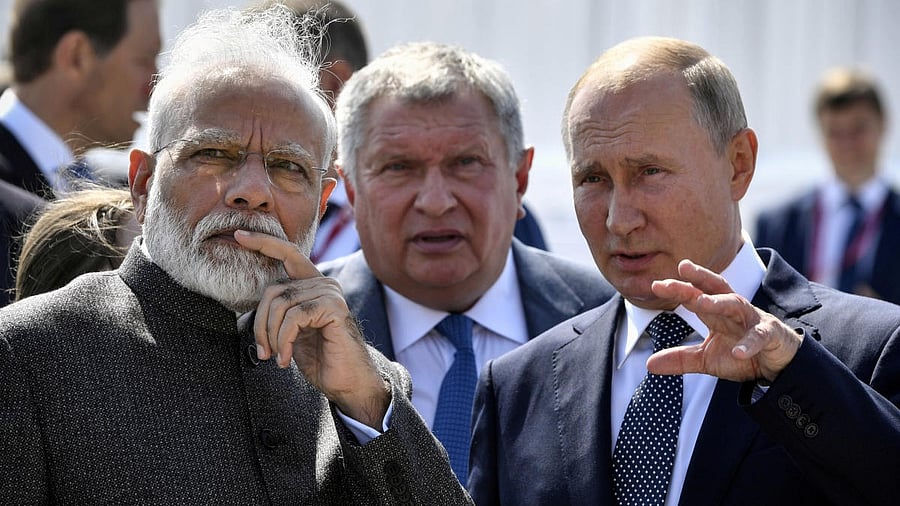
Russian President Vladimir Putin and Indian Prime Minister Narendra Modi seen with Rosneft CEO Igor Sechin (centre)
Credit: Reuters File Photo
A Washington Post report last week quoted United States officials that as “a parting blow to Putin’s war chest”, the Biden administration is considering major new financial sanctions on Russian oil in its final weeks in office that would also target the “dark fleet” of international ships, many of them of Indian origin, carrying it to non-Western markets. The Post adds, ‘If implemented, the penalties could help shape Biden’s economic and foreign policy legacies before Trump’s inauguration. A major move against Russia before leaving office would bolster Biden’s claims to have rallied Western allies to respond forcefully to the 2022 invasion of Ukraine.’
India, a top dog among the main buyers of Russian oil, continues to be in the West’s crosshairs. The ‘dark fleet’ mainly operates out of Russia’s ports in the Baltic Sea, which is, therefore, going to be a theatre for NATO to throttle Russia’s oil exports. The ploy by the United Kingdom and Northern European countries is to impose nothing less than a naval blockade of the Baltic Sea under the guise of insurance checks of oil tankers carrying Russian oil.
Interestingly, this comes after the announcement of the recent mega deal between Rosneft and the Reliance Industries whereby the Russian oil giant will supply nearly 500,000 barrels of crude oil daily to the Indian company, which operates the world's largest refinery, marking the biggest India-Russia energy deal ever, valued at $13 billion per year at current prices. The Urals blend, which is the object of the Rosneft-Reliance deal, and which constitutes the main share of India's Russian oil imports, is exported through the ports of Primorsk and Ust Luga in the Baltic Sea.
The issue has two aspects. One alternative is to divert the shipments from Russia to India through the upcoming Northern Sea Route (NSR) but investments in infrastructure will be required to get the Ural oil to Arctic ports and vessels able to navigate the NSR still need to be ice-classed and the crew properly trained for ice navigation.
More importantly, therefore, India and Russia need to sort out the insurance issue. There is a cartel of Anglo-Saxon mutual insurers underwriting shipowners’ liability risks at a limit of $3.1 billion per occurrence. The cartel falls within the ambit of the infamous ‘rules based order’. Simply put, it is a Western monopoly.
Without such insurance, a ship is not able to trade as markets and regulators (port authorities) demand it. As reinsurance is a Western monopoly and given that virtually all private insurers depend on the USD financial market, there is simply no alternative as long as state reinsurers or sovereign wealth funds do not provide marine reinsurance capacity.
One way out could be that a Russian-Indian reinsurance venture would allow to ‘recycle’ any Rupee current account surplus in the bilateral trade into buffer capital for reinsurance policies underwritten in INR or in freely INR exchangeable currencies such as the UAE Dirham.
Indeed, the marine insurance problem can be relatively easily solved if only state reinsurers would provide alternative capacity to private insurers. Unfortunately, apart from a cursory statement of intent in the BRICS Kazan declaration, not much seems to be happening for now.
Fundamentally, this is also a diplomatic issue insofar as the Western moves denying merchant vessels the right of innocent passage in the Baltic Sea ignore international law on straits as laid down in UNCLOS. In reality, what the Western powers are attempting is what the Ansar Allah does in the Red Sea — minus the missiles but adding hypocrisy.
A long-term solution lies in the Vladivostok-Chennai maritime corridor, which provides a way to avoid the Danish Straits for the security of supply of energy and raw materials from Russia to the Indian economy. The link between the NSR and the Vladivostok-Chennai corridor will be ship-to-ship transfers at Vladivostok between ice-classed vessels and ordinary tankers or bulk carriers.
It also allows the NSR to connect to the International North-South Transport Corridor. Thus, a full circle of Eurasian connectivity is created, facilitating trade and investment between India and Russia. This closed loop allows them to balance their economic alliances in sync with the ‘balancing role’ of India in BRICS — creating economic conditions for real multipolarity.
As regards container shipping, Chennai (and the new Vizhinjam Port (which is also India's first deep water transshipment terminal close to major East-West shipping lanes)) opens possibilities for opportunistic loading. On this route the world's largest container vessels are deployed where, as of now, ships return from West to East with significantly less cargo. Russia-destined containers can be loaded in Chennai or Vizhinjam at very low cost. As such, the Chennai-Vladivostok route becomes a viable alternative for direct connections between India and Russia, for which much smaller ships are currently used.
(M K Bhadrakumar is a former diplomat.)
Disclaimer: The views expressed above are the author's own. They do not necessarily reflect the views of DH.